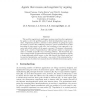116
Voted
SAC
2011
ACM
14 years 3 months ago
2011
ACM
Spatial networks like transportation, power, and pipeline networks are a ubiquitous spatial concept in everyday life and play an important role for navigational and routing purpos...
106
Voted
IFIP
2010
Springer
14 years 7 months ago
2010
Springer
This manuscript addresses the creation of scenario-based models to reason about the behavior of existing industrial information systems. In our approach the system behavior is mode...
105
click to vote
COORDINATION
2009
Springer
14 years 10 months ago
2009
Springer
Abstract. Recent approaches to component-based software engineering employ coordinating connectors to compose components into software systems. For maximum flexibility and reuse, s...
114
click to vote
JOT
2010
14 years 11 months ago
2010
The separation of concerns (SOC), as a conceptual tool, enables us to manage the complexity of software systems that we develop. The benefits of this paradigm, such as reuse, enhan...
91
Voted
FUIN
2010
14 years 11 months ago
2010
A formal model for diagnostics of biological systems modelled as P systems is presented. We assume the presence of some biologically motivated changes (frequently pathological) in ...
93
Voted
TSE
2002
15 years 5 days ago
2002
TOSEM
1998
15 years 5 days ago
1998
Many software process methods and tools presuppose the existence of a formal model of a process. Unfortunately, developing a formal model for an on-going, complex process can be d...
103
Voted
RAS
1998
15 years 6 days ago
1998
We present a formal model of negotiation between autonomous agents. The purpose of the negotiation is to reach an agreement about the provision of a service by one agent for anoth...
114
click to vote
LOGCOM
1998
15 years 6 days ago
1998
The need for negotiation in multi-agent systems stems from the requirement for agents to solve the problems posed by their interdependence upon one another. Negotiation provides a...
FUIN
2007
15 years 15 days ago
2007
A formal model for description of passive and active timing attacks is presented, studied and compared with other security concepts. It is based on a timed process algebra and on a...




